|
|
|
|
|
|
Report
sightings |
|
|
|
|
|
|
Report
sightings |
Saturday 31st:
At least one Roseate Tern was still
offshore with 27 Common Tern, also present two Balearic Shearwater,
a Red-throated Diver and two Arctic Skua. Over the high tide there
were 30+ Dunlin, 10 Sanderling, 10 Ringed Plover, two
Grey Plover and a Bar-tailed Godwit.
Friday 30th:
At least one Roseate Tern was still
offshore whilst 50 Common Scoter and a Balearic Shearwater
flew south.
Thursday 29th:
The feeding flocks offshore attracted two Balearic Shearwater
and two Roseate Tern along with 200+
Kittiwake, two Arctic Skua, 23 Common Scoter, 35 Common,
30 Sandwich and a Little Tern.
In the estuary there were 60 Dunlin, 30 Sanderling, 19 Ringed
and 10 Grey Plover, four Bar-tailed Godwit and two Whimbrel.
Elsewhere a Hobby flew through the
Entrance Bushes early morning, a Jay
was again in Dead Dolphin Wood, two Great-spotted Woodpecker and at least
nine Reed Warbler were on site, single Collared Dove and
Chaffinch flew east and two Peregrine harassed the
waders.
Wednesday 28th:
The morning high tide saw 80 Common, 30 Sandwich, two
Little and an
Arctic Tern roosting in front of hide.
Around the Bight several flighty wader flocks included 100 Sanderling ,
40 Dunlin, seven Grey and five Ringed Plover, two Knot
and a Bar-tailed Godwit. Offshore c50 Common Scoter flew south
with just four on the sea, tern numbers had dropped by evening but there were 20
Gannet, five Manx Shearwater and a
Pomarine Skua.
Tuesday 27th:
A quiet day with three Reed Warbler being new arrivals and the wader
counts from the high tide including 64 Sanderling, 36 Dunlin, 31 Ringed
Plover and a Whimbrel. Offshore there were 10-15 Manx Shearwater
and 11 distant Common Tern. Elsewhere small numbers of Swallow
and Swift continue to pass through and Whitethroat were feeding
fledged young near the Dune Pond.
Monday 26th:
A Balearic Shearwater flew north early morning with
it or another lingering in the afternoon, also offshore seven Common Scoter,
six Manx Shearwater, an
Arctic Skua, 65 Common and three
Black Tern. The wader
numbers dropped from yesterday with totals of 54 Dunlin, 24 Sanderling,
23 Ringed
Plover, seven Grey Plover and a Bar-tailed Godwit.
Sunday 25th:
Large numbers of birds were still feeding offshore with 275 Manx Shearwater,
50+ Kittiwake, three
Arctic Skua, 120+ Common (commic), an
Arctic and a
Little Tern. A pair of
Tufted Duck in off the sea and up the
estuary were unusual for the time if year. In the estuary an influx of waders
overnight gave totals of 113 Dunlin, 42 Sanderling, 17 Ringed
and 13 Grey Plover, two Knot and two Turnstone. Elsewhere a
Great-spotted Woodpecker was again the Entrance Bushes and 18 House Martin were over Shutterton Creek.
Saturday 24th:
A Jay in Dead Dolphin Wood and then
the Entrance Bushes was a surprise, the first record of the year. Offshore a
large feeding flock included 350+ Kittiwake, 40+ Gannet, 23
Common Tern, 20+ Manx Shearwater and 20 Black-headed Gull. A
first summer Little Gull, three
Arctic Skua and a first summer commic tern were also present. Waders were
limited to 513 Oystercatcher, 37 Curlew, 15 Dunlin and two
Sanderling. A light
passage overhead included 30+ Swallow, 27 Swift and two House
Martin.
Friday 23rd:
The only news received for today was of 10 Turnstone and nine
Sanderling.
Thursday 22nd:
The long overdue first Cuckoo of the
year was seen in Greenland Lake during the afternoon. Over the high tide where
there were 61 Sandwich and a Common Tern, 12 Black-headed Gull,
12 Grey Plover, eight Turnstone, eight Dunlin and a
Ringed Plover in the estuary. Offshore 30+ Manx Shearwater were
present in the evening.
Wednesday 21st:
A very quiet day with only a handful of waders including 30
Sanderling, 12 Grey Plover, five Bar-tailed Godwit, three
Whimbrel and three Dunlin. Offshore 10 Black-headed and a
first summer Mediterranean Gull but no Common Tern.
Tuesday 20th:
An Arctic Skua was offshore in the evening along with c80 distant 'commic'
Tern, a single Little Tern and at
least five Manx Shearwater. Wader numbers were limited to the same flock
of 36 Sanderling, plus single Dunlin and Ringed Plover.
Monday 19th:
Terns were still present offshore in some numbers with one Roseate
and c40 Common Tern in the morning but with c120 'commic' Tern in the
evening including one Roseate and
c40
Arctic Tern, a very high site count. Also offshore a
pale phase Pomarine Skua
headed south, 42 Common Scoter
and five Manx
Shearwater. Wader numbers continue to drop with 36 Sanderling,
c30 Dunlin, 11 Grey Plover and two Bar-tailed Godwit, plus
single Knot, Whimbrel and Turnstone. Elsewhere the
Cirl Bunting was again singing early
morning, a first summer Mediterranean Gull on Finger Point was the first
for over a month, a Peregrine was on a kill in the Bight early morning,
320 Herring Gull roosted on Finger Point with c500 more offshore.
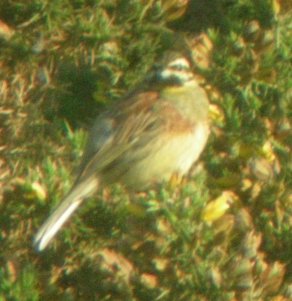
Cirl Bunting
Sunday 18th:
Large numbers of birds were again feeding offshore during the day with at least
three Roseate and an
Arctic Tern
with c290 Common (commic) and 40 Sandwich Tern. Also offshore a
Puffin, the first of the year, flew
south with two Razorbill at 7am, an Arctic Skua, 60 Manx
Shearwater and c20 Common Scoter. Three Great Northern Diver
were also recorded, these all came down the river & headed south, the first two,
both in summer plumage came down together at just before 6am, the third bird, in
winter plumage about an hour later. Migrants included a Spotted Flycatcher
and a Garden Warbler with a small but steady early morning passage of
Swift, Swallow and House Martin. Wader numbers again dropped
with 44 Dunlin, 36 Sanderling and nine Turnstone.
Saturday 17th:
A Turtle Dove flushed from near the
Main Pond was the first of the year for this increasingly rare visitor but the
only other migrants found were three Wheatear on the beach. Wader numbers
increased overnight with 346 Dunlin, including several arctica
race, at the morning high tide, but many continued north through during the day
with only 100+ were present come the evening, other counts included 42
Turnstone, 34 Sanderling, 12
Whimbrel, eight Bar-tailed Godwit, six Grey Plover and two Knot.
Large numbers of birds were again feeding offshore in the evening including five Roseate Tern with c200 Common, 16+ Arctic and four Little Tern. These flocks attracted in a fully spooned pale phase Pomarine Skua before it headed off south. Also offshore 40+ Manx Shearwater, 30+ Black-headed Gull and 15 Common Scoter. Elsewhere a Redshank was a first for the Main Pond and the pair of Red-breasted Merganser were in the estuary.
Friday 16th:
Wader passage continued with 234 Dunlin and 78 Sanderling in the
estuary along with 308 Oystercatcher, 34 Curlew, 27 Ringed
Plover, 16 Grey Plover, eight Bar-tailed Godwit, three
Whimbrel and two Knot. Offshore a large feeding raft included 262
Gannet, 152 Kittiwake and 80+ Manx Shearwater, although tern numbers had dropped there
were still four Little and an
Arctic Tern. Elsewhere the
Cirl Bunting continued to hold territory, the Slavonian Grebe
was in the estuary, two
Spotted Flycatcher were on site and a Collared Dove flew
through.
Thursday 15th:
The overnight thunderstorms no doubt brought in the highlight - a
Wood Warbler in trees behind the Crocus Compound, this
is only the 12th reserve record and the first for 10 years. Three
Spotted Flycatcher around the site were
also firsts for the year, but there was nothing else in the bushes to suggest a
fall of migrants, with a Great-spotted Woodpecker in the Entrance Bushes
just a foraging bird from nearby. In the estuary however wader numbers had
increased and continued to build during the day with evening counts of 214
Dunlin, 67 Turnstone, 44 Sanderling, 38 Ringed Plover,
18 Whimbrel, 17 Grey Plover, nine Bar-tailed Godwit, three
Knot and a Greenshank. Also in the estuary a pair of
Red-breasted Merganser and the summer plumaged Slavonian Grebe.
Offshore tern numbers also increased with c250 Common, at least 10
Arctic, six
Little, six
Black and two
Roseate Tern along with
85+ Manx Shearwater and a distant diver sp. Elsewhere 12 Swift
passed through with single figures of Swallow and two House Martin
and five young Coot were on the Main Pond.
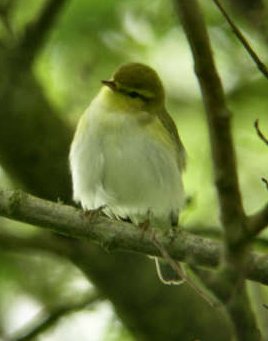
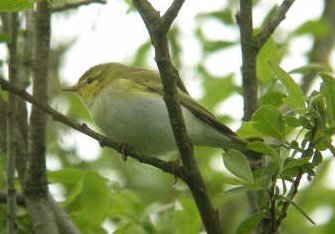
Wood Warbler 15/05/08 © Ivan Lakin
Wednesday 14th:
The reappearance in the estuary of the summer plumaged
Slavonian Grebe was the highlight, the
latest ever spring record, also in the estuary 38 Sanderling, six
Dunlin, six Grey Plover, four Bar-tailed Godwit, two
Knot and two Whimbrel. Offshore a raft of 70 Manx Shearwater,
47 Common (commic) and at least one
Arctic Tern.
Tuesday 13th:
A Greenshank in the estuary was the only obvious new migrant on site,
other waders included just five Sanderling, four Bar-tailed Godwit
and a Redshank. Offshore a feeding group of 200 Kittiwake and c20
Common Tern, but these were moved on by constant jet ski activity.
Monday 12th:
Another midsummer like day with the only reported received being two Arctic
Skua and 40 Manx Shearwater south offshore and the surprise
appearance on the Golf Course of the first Cirl Bunting of the year. This
species is rare on the reserve during the breeding season.
Sunday 11th:
A hot cloudless and birdless day with viewing conditions not helping either!
Offshore only seven Common
(commic) Tern were present in the morning along with c20 Manx Shearwater and
a Red-throated
Diver. Wader counts had again dropped with only 21 Grey
Plover, 16 Sanderling, 10 Dunlin and a Ringed Plover.
Saturday 10th:
Offshore a single Roseate
Tern remained with 150+ Common
(commic) Tern. Also present a Velvet Scoter
with 36 Common Scoter and single Great Northern and Red-throated
Diver. Wader counts over the high tide included 36 Dunlin, 21 Grey
Plover, 11 Turnstone, nine Knot, seven Sanderling,
four Ringed Plover (inc one tundrae race), three Bar-tailed Godwit and a Redshank.
Elsewhere a Sedge Warbler was by the First Pond.
Friday 9th:
The overnight conditions promised a fall of migrants but this seemingly only
applied one species with the reserve's 11th, 12th and 13th records of
Nightjar being found! The first, a male, was flushed
from Dead Dolphin Wood and was later found roosting there in full view.
The second, a female, was seen several times mostly in flight round the First
Pond and the third, another male, was seen flying and even heard churring over the
Back Meadow mid evening, whilst the first bird was still roosting. Other migrants were limited to a Garden Warbler, two new Reed
Warbler and three Collared Dove east with 230 Swallow and a
Swift. Offshore there were 260 Common
(commic), three
Little, at least two Arctic
and a Roseate
Tern. Also offshore a raft of 140+ Manx
Shearwater, an Arctic Skua and three Red-throated
Diver. Wader counts over the high tide included 53 Dunlin, 39 Turnstone, 17 Sanderling, 12 Ringed Plover
and a Redshank.
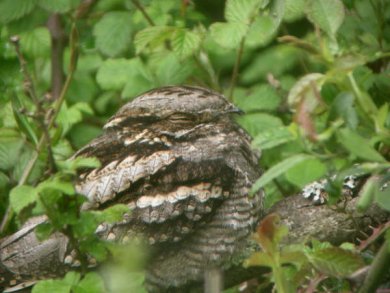 Nightjar 09/05/08 © John Fortey |
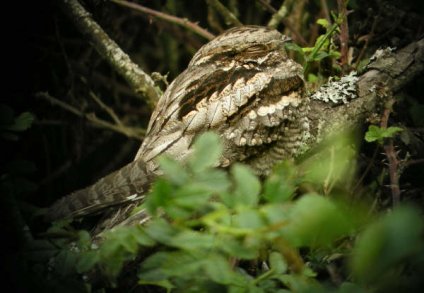 |
Thursday 8th:
Much of the interest remained offshore c80 Common Tern along with 60 Sandwich,
at least two Arctic and singles of
Roseate,
Little and
Black Tern. Also offshore 35+ Manx
Shearwater, c40 Common Scoter and a summer plumaged Red-throated
Diver. Wader counts over the high tide included 57 Whimbrel, 35
Dunlin, 21 Grey Plover, 13 Turnstone, 13 Ringed Plover,
10 Knot, 10 Bar-tailed Godwit and nine Sanderling.
Wednesday 7th:
Offshore early evening, there were at least 80 Common (or Commic) Tern
feeding distantly along with several rafts totalling 96 Manx Shearwater
and c20 Common Scoter. Wader counts over the high tide included 25
Grey Plover, 15 Whimbrel, 12 Dunlin, 11 Sanderling, six
Knot, three Bar-tailed Godwit and two Turnstone. Elsewhere,
a Common Sandpiper on the Beach was
the first of the year and a single Rook flew east.
Tuesday 6th:
The only sightings reported for today were single
Black and
Roseate Tern offshore with c40 Common Tern.
Monday 5th:
The highlight of the day was the second reserve record of Purple Heron, a first summer which flew high east following the coast at 5.50pm. Otherwise attention was again focussed offshore with c250 Common Tern present during the morning with 40 Sandwich, at least 10 Arctic, four Black, two Roseate and two Little Tern. With them were 20+ Manx Shearwater, 73 Common and the drake Velvet Scoter, four Red-throated Diver and a Great-crested Grebe. Aside from the heron other birds passing east included a Hobby, four Collared Dove, four Yellow Wagtail, c200 Swallow, two Swift, five House and two Sand Martin. Counts from the estuary included 80 Dunlin, 25 Grey Plover, 20+ Whimbrel, nine Knot, seven Ringed Plover, four Sanderling, two Bar-tailed Godwit and a Redshank with a pair of Gadwall in Shutterton Creek a rare May record.
Sunday 4th:
Most of the interest remained offshore where, with peak counts in the evening, c280 Common Tern continued to feed with at least 15 Arctic, two Roseate and a Little Tern. With them were 30+ Manx Shearwater, upto 70 Common and a Velvet Scoter, three Red-throated Diver and five Great-crested Grebe, with an Arctic Skua making a brief appearance. Other birds passing through included 28 Pale-bellied Brent Geese, the first Hobby of the year and a drake Garganey close in to the east, before heading upriver. Counts from the morning high tide included 44 Dunlin, 24 Sanderling, 19 Grey Plover, 18 Turnstone, nine Knot, five Ringed Plover and two Bar-tailed Godwit. Elsewhere a Buzzard flew east, a Yellow Wagtail was flushed off the Main Pond and a second flew east late afternoon.
Saturday 3rd:
A single Wheatear in the Buffer Zone was the only grounded migrant, but overhead there were 141 Swift with 47 Swallow and 18 House Martin. Large numbers of birds were feeding offshore early morning included two first summer Little Gull, c75 Common and at least one Arctic Tern, c50 Common Scoter, 40+ Kittiwake and c20 Manx Shearwater. These feeding flocks were however soon dispersed by a record 39 Kite surfers off Exmouth. By late afternoon the kite surfer numbers had dropped and the feeding flocks again appeared. These were very active, with some birds seeming to come in before continuing south, so counting was impossible with possibly up to 3-400 Common Tern, with a minimum count at least 120. With them were minimum counts of four Arctic, two Roseate, two Little and a single Black Tern, but numbers of all species were probably higher. Also offshore in the evening seven Pale-bellied Brent Geese. However surprisingly despite the numbers of terns there were no skuas present. Also offshore three Red-throated and a Great Northern Diver. Elsewhere two Collared Dove were briefly over the car park, and in the estuary 23 Dunlin, 18 Grey Plover, eight Knot and four Ringed Plover.
Friday 2nd:
Overnight showers had dropped in a few migrants with a Lesser Whitethroat around the Back Meadow and three Sedge Warbler on site, along with a good count of 22 Whitethroat and four Wheatear. Three Collared Dove were flying around the Buffer Zone early morning but otherwise there were just two House Martin overhead with five Jackdaw and a single Rook. Elsewhere 39 Pale-bellied Brent Geese and 38 Whimbrel were in the estuary, two Little Grebe were on the Main Pond, two Peregrine were sat on Warren Point, a Great Northern Diver flew south and a second bird, in summer plumage flew high north up the estuary, the fifth such record this spring.
Thursday 1st:
Seawatching during the morning produced the first two Pomarine Skua of the spring flying south along with six Manx and three Balearic Shearwater, single Arctic Skua, Red-throated Diver and Little Egret, a single Pochard in off was unseasonal. Also offshore c50 Common Scoter, a summer plumaged Red-throated Diver and 54 'commic' terns were feeding distantly. In the evening a single Arctic Tern was present with a close group of 41 Common Tern. A small arrival of migrants overnight was limited to a Yellow Wagtail over the Bight, three new Willow Warbler and a Wheatear, other migrants on site including 11 Whitethroat, five Chiffchaff and a Blackcap have been holding territory for over a week now. Elsewhere two Rook flew east, a Great Northern Diver was in the estuary and on a low tide there were just eight Dunlin, six Whimbrel, five Ringed Plover and two Little Egret.
Back |
April 2008 |
Home